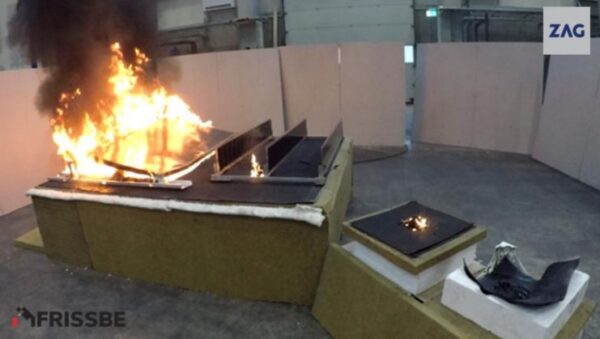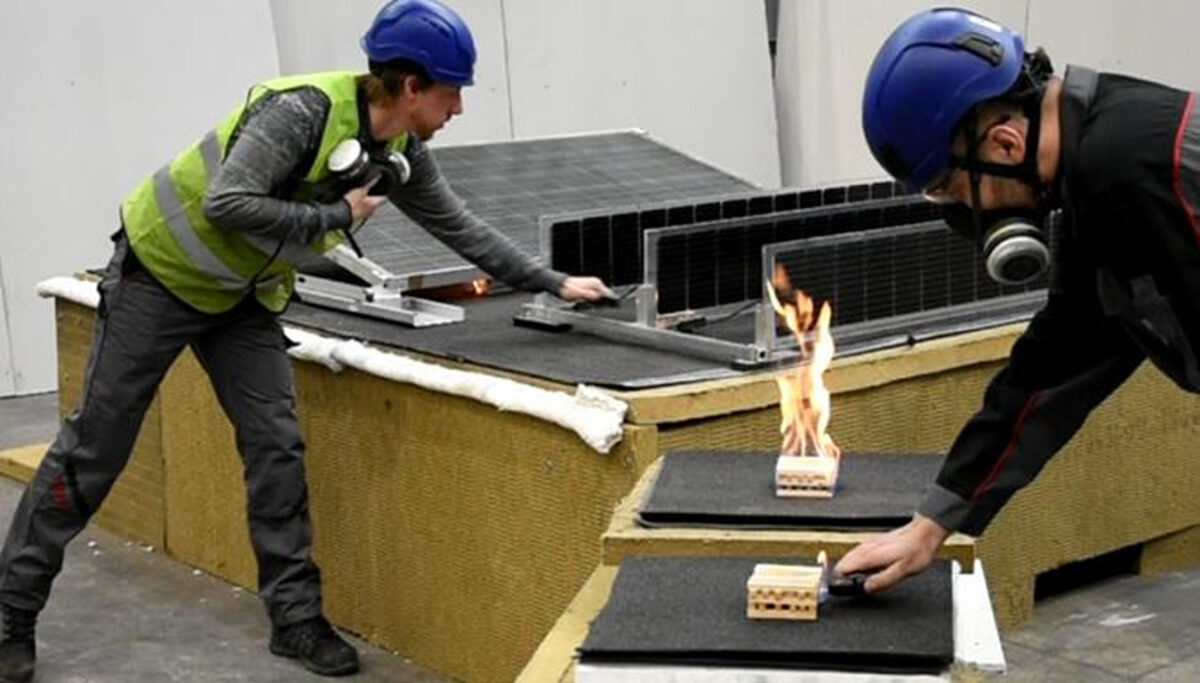Researchers from the Slovenian National Building and Civil Engineering Institute (ZAG) recently carried out a series of tests to assess the fire safety parameters of vertical rooftop PV systems and found these installations offer improved parameters compared to conventional rooftop arrays.
For the testing, the scientists utilized vertical solar modules provided by Norwegian specialist Over Easy and Italian certification body Istituto Giordano. They also used a typical configuration of inclined PV panels as a benchmark. Two standalone samples were placed at an angle next to the larger roof segment.
In one of the buildups, the expanded polystyrene insulation (EPS) was directly covered by a membrane made of two layers of bitumen. It also included mineral wool below the EPS to protect the parts below and to have both samples at a similar height. Mineral wool was not considered a part of the roof in this case.

Image: Slovenian National Building and Civil Engineering Institute
In the second buildup, an additional mitigation layer based on mineral wool was positioned between the insulation and the top cover. The same roof structure made of bitumen, mineral wool, and EPS was also used for this setup.
The panel used for the traditional configuration was a pre-used panel with glass on top and a polymer backsheet mounted on an aluminum mounting system, with the dimensions being approximately 1.6 m x 1.0 m. The vertical panels were also pre-used bifacial panels with glass on both sides and placed on an aluminum mounting system. The dimensions of these panels are 1.6 m x 0.25 m. They were installed at a distance of 0.4 m between each other.
“A wood crib was used as an ignition source as recommended by some standards and also because the heat transfer of a burning wood crib goes in all directions, including all forms of heat transfer,” ZAG's fire safety expert, Grunde Jomaas, told pv magazine. “This creates a fire that is in direct contact with the roofing membrane, all of which is deemed more challenging than a gas burner or other potential sources of ignition, while also being more realistic.”
The locations of the cribs were chosen to reflect the worst-case scenario for both configurations with panels. For the inclined configuration, the crib was located close to the bottom edge of the panel where the height between the membrane and the backside of the panel was 11 cm to reflect recent findings about fire spread below PV panels. For the vertical configuration, the crib was located next to the junction box. For the other setups, the crib was positioned in the middle of the samples.
“Before the ignition, the cribs were soaked with 5-6 mL of isopropyl alcohol to ensure fast and uniform ignition of all parts of the cribs,” Jomaas explained. “After soaking the cribs, all four of them were ignited within less than 5 seconds by a lighter.”

The test showed that the fire on the unmitigated sample was extinguished around 12.5 m after the ignition due to the deformation of insulation and to prevent all of the EPS from burning. The fire under the PV panels was extinguished around 15 m after the ignition after the whole inclined panel got engulfed by the flames.
“It should be noted that very limited damage to the EPS was observed even for the bigger fire,” Joomas emphasized. “As such, the mineral wool provided a very good mitigation layer for this buildup, which could represent a typical buildup for an existing roof where the EPS needed a mitigation layer to avoid its complete involvement.
According to Jomaas, the comparison of the vertical and the inclined PV panels demonstrates “vividly” that the inclined panels create conditions that enable fire to spread rapidly on the roof membrane. “The same materials in other cases do not allow the flame to propagate”, he explained. “Secondly, having no mitigation layer between the roof membrane and insulation that is prone to damage from heat is strongly advised against, independent of the type and geometry of the PV panels installed on top.”
“With vertical solar panels, there is no cavity for the fire to spread,” the CEO of Easy Solar, Trygve Mongstad, told pv magazine. “We don’t want to create any panic though, regular solar panels are also normally very safe, but it illustrates that there are more benefits to vertical solar panels on flat rooftops, and for certain buildings where fire safety is of extra concern, we believe that we may provide a good solution.”
The results of the experiment have not been confirmed so far by a third-party entity.
A video of the experiment is available at this link.
This content is protected by copyright and may not be reused. If you want to cooperate with us and would like to reuse some of our content, please contact: editors@pv-magazine.com.




By submitting this form you agree to pv magazine using your data for the purposes of publishing your comment.
Your personal data will only be disclosed or otherwise transmitted to third parties for the purposes of spam filtering or if this is necessary for technical maintenance of the website. Any other transfer to third parties will not take place unless this is justified on the basis of applicable data protection regulations or if pv magazine is legally obliged to do so.
You may revoke this consent at any time with effect for the future, in which case your personal data will be deleted immediately. Otherwise, your data will be deleted if pv magazine has processed your request or the purpose of data storage is fulfilled.
Further information on data privacy can be found in our Data Protection Policy.